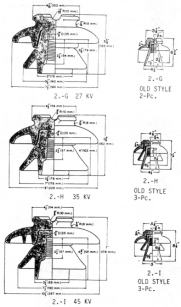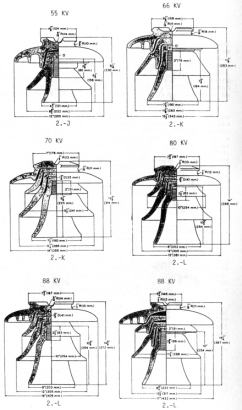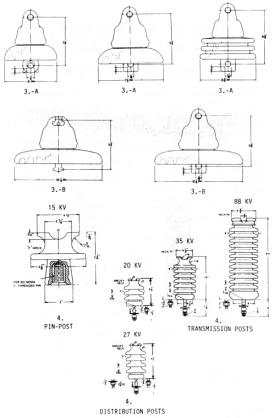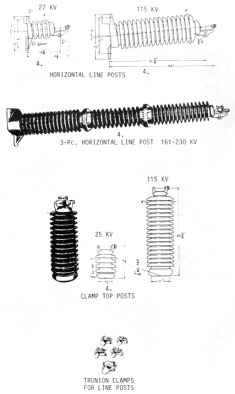Applications of Electrical Porcelain Power Insulators (Part two of two parts)
by Robert L. Winkler
Reprinted from "Crown Jewels of the Wire", February 1988, page 25
(Reference drawings to this article are on the pages following the article.)
2. PIN TYPE INSULATORS (continued)
2G. One or Two Piece Cemented Top-Tie - 23-27 KV
Designed for High Voltage Primary Distribution these units are still in general use and production.
Most have either a porcelain or stamped zinc thimble with 1-3/8 inch pin
threads.
In recent years, it has been found desirable to manufacture these high
voltage pin types in two or more pieces (shells) . At transmission voltages,
lightning stroke or surge over-voltages on lines can flashover and seriously
damage or puncture the highest quality modern one piece pin insulator. Multipart
designs help to minimize the electrical stress on these high voltage insulators
by distributing the surge voltage over two or more electrical barriers with
greater flashover/leakage distances, decreasing the possibility of flashover
puncture and insulator failure. Also, in the event of puncture or damage to one
shell of the multipart insulator, in most cases, the remaining good shell (or
shells) will usually support and insulate the line until replacement can be
made.
2H. One or Two Piece Cemented Top-Tie - 35 KV
Still in production, these units are used on Primary Distribution or
Subtransmission lines up to 34.5 KV. Pin holes
are the same as for 27KV units. Early units 1902-1920 were often of three piece
design.
2I. One or Two Piece Cemented Top-Tie - 45 KV
Still in production, these have been the standard pin insulator on 34.5 KV
transmission lines across the U.S. from the early 1920's until the advent of the
line post began to end their general usage. Pin holes are the same as for 35 KV
units. Early units 1902-1920 were often of three piece design.
Some 45-69 KV pin types employed clamp top caps similar to those used on
modern line post insulators.
2J. Two Piece Cemented Top-Tie - 55 KV
These Transmission units and the pin types to follow, are all
generally out of production in the U.S. At voltages above 34.5 KV, line posts
have virtually ended the use of pin types for new construction during the past
15 years or so. Pin holes are the same as for 45 KV units. Early styles also
were made in three pieces.
2K. Three Piece Cemented Top-Tie - 66-70 KV
A popular Transmission insulator for many years on 66 KV (later 69
KV) . Some units were also made in four piece styles. One major manufacturer
offered a four piece version for "69 KV severe contamination" as
late as 1976. Pin holes are the same as for 55 KV units.
2L. Four Piece Cemented Top-Tie - 80-88 KV
Often employed as contamination units on 69 KV Transmission lines,
these are the top range in sizes of pin type line insulators generally. The 88
KV units have a top diameter of 16 to 17 inches and weigh from 47 to 54
pounds. Pin holes range from 1-5/8 to 2 inches in diameter, the largest size
offered was usually a special order pin.
3. SUSPENSION INSULATORS
At voltages from 34.5 to 69 KV, suspension insulators are widely used. At
voltages above 88 KV, suspensions were used almost exclusively until the advent
of post insulators which are now operating on lines up to 230 KV.
3A. Distribution Dead-End
Used primarily to dead-end conductors on Secondary or Primary
Distribution lines up to 15 KV. These units are also used on line angle
structures where crossarms are not required.
3 B. Ball and Socket or Clevis Bell Type Suspension
Coupled together in strings of any number, these versatile insulators are
the "backbone" of the High Voltage and Extra High Voltage
Transmission (EHV) systems in the U.S. In fact, even on pin type or post
insulator equipped transmission lines, great quantities of suspension
insulators will be found in dead-end, line angle, junction/switch pole or
jumper loop support positions throughout the system.
Typical voltages generally carried on lines per number of units in the string
are as follows:
10" Bell
No. per string |
Line voltage
KV |
| 1-2 |
Up to 27 |
| 2-4 |
34.5 |
| 4-6 |
69 |
| 8-10 |
115-138 |
| 10-12 |
138-161 |
| 14-16 |
161-230 |
| 19-22 |
345 |
Lines up to 765 KV and above have been constructed in recent years using
modern high-strength suspension insulators.
4. LINE and DISTRIBUTION POST INSULATORS - 15-230 KV
Although not generally collector items and usually of recent vintage, line
post insulators are of importance to the evolution of overhead line construction
and even to collectors as they have been widely used in recent years replacing
older pin types which have found their way into the hands of happy collectors,
courtesy of the line post.
Line posts are generally used on Primary Distribution and Transmission
systems with voltage ranges from 15 to 345 KV. 345 KV units are only recommended
for jumper loop or similar slack span duty.
The smallest and most recent version of post insulators was developed about
1975 called the Pin-Post. Rated at 15 KV, these units have a standard one inch
thread in the post shaft with a very thick head section including a tie-top and
single petticoat, much like the head and top skirt of a standard distribution
post insulator. Presently, these are used mainly in the Chicago area and are
only manufactured by two companies in 1986 as non-catalog items.
The standard line post insulator series can be divided into distribution and
transmission styles differing in size and the number of skirts but having the
same general "straight up and down" profile as a batch of dinner
plates stacked one on one. The central core of these insulators is either hollow
or solid. Since they do not have metal inserts within the body (such as an
insulator pin), they can be manufactured in one piece for voltages up to 115-138
KV due to their basic design and exceptional ability to withstand
flashover/puncture surge voltage. Units 138 KV and above are generally made in
sections for easier manufacturing, shipping, handling and etc. The sections have
flanged iron end caps which are bolted together.
Line and distribution posts come with either a tie-top porcelain head or a
metal cap cemented to the top, as a basic option, for a conductor clamp. All
have a metal base cemented to the lower end. Units for mounting to a crossarm,
bracket or structure have a cup shaped base with a single pin stud passing
through the arm. Units for horizontal or "armless" construction have
an elongated flat or slightly curved base to fit around a pole. The base has two
holes for bolting to the structure.
While the above mentioned line posts and other units of recent vintage might
not generally turn the head of most insulator collectors, I hope that this
information may at least cause the collector to view these insulators with a
little admiration for all they have done, are doing and will do, for years to
come, the next time he "looks up".
NOTE: Insulator styles shown here for general information only.
Design shape details and dimensions often varied noticeably between different
manufacturers over many years of the same voltage classification of each
insulator.

Medium Image (106 Kb)
Large Image (214 Kb)

Medium Image (185 Kb)
Large Image (378 Kb)

Medium Image (146 Kb)
Large Image (295 Kb)

Medium Image (115 Kb)
Large Image (239 Kb)
| 